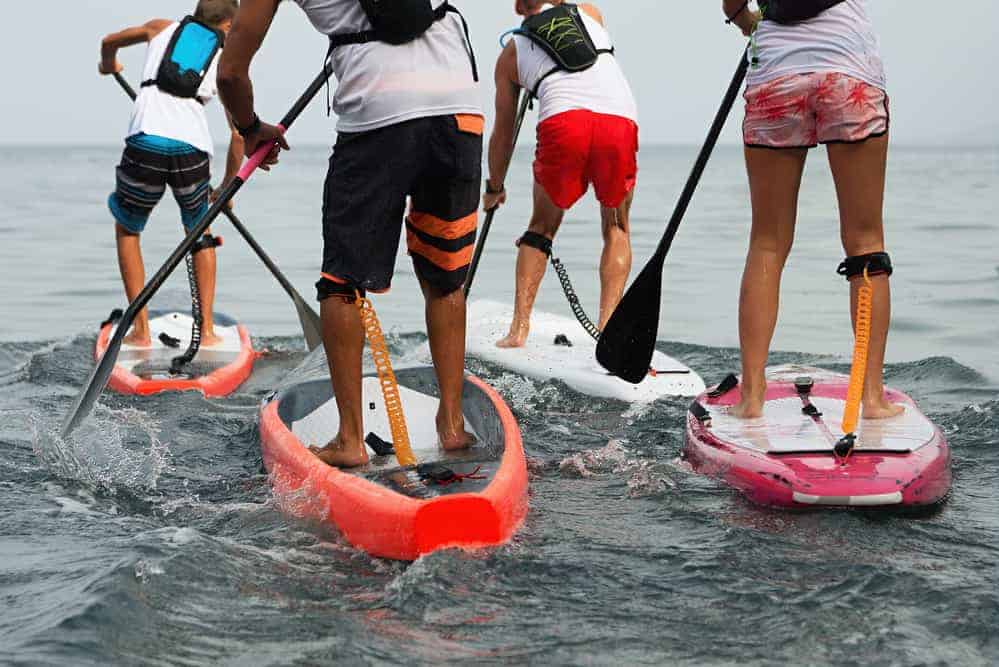Embarking on a new adventure on the open water can be quite a thrill, but before you go paddling into the waves like a pro surfer, it’s important to know the basics.
After all, we’ve all seen re-runs of Baywatch, and you don’t want to be the guy David Hasselhoff has to save off a paddle board. Trust us.
Whether you want to kayak, paddle board, or surf, it is important to know what a SUP is, and what the best SUP model will be for your preferred activity.
Understanding the basics behind paddle board for beginners is the best initial step in this process, and we’re here to guide you every step of the way.
The following guide will teach you all you need to know about stand up paddle boards (SUPs).

First, what is a SUP?
SUP isn’t just something you say to your friends as a greeting, it stands for “Stand Up Paddle board”. Stand up paddle boards historically stem from surfing, except with the use of a surf board and a long paddle in combination. This type of board can be utilized in a variety of activities and is a great way to work out while also having a blast on the water.
Invest in Lessons – it’ll help
Before purchasing your SUP, it is essential to have exposure to different boards, and how to properly use a SUP in the first place.
By taking lessons prior to shopping for your SUP, you can learn from an expert instructor who can teach you what to look for when buying a paddle board, and better understand the types that might be more suitable to your style, body type and activities you wish to pursue on them.
Different Types of SUPs – type matters
Stand Up Paddle boards come in a wide range of different styles. We’ve gone ahead and researched the different kinds of paddle boards for beginners, so you don’t have to.
By the time you finish this guide, you’ll feel confident in having explored all of your options and ready to choose the perfect SUP.
All Around SUPs – The Jack of all trades
An All Around Sup is perfect for beginners. These boards are flexible and can be utilized in a wide range of activities.
The all-around SUP’s shape and design makes it ergonomically and easy to use for the whole family. Even dogs don’t struggle to balance well on all around SUPs.
Surf SUPs
The Surf SUP is a more appropriate choice for those who are intermediate or advanced users. These boards have less balance, making them easier to fall off of and provide a more athletic and sporty experience.
Think of a Surf SUP as basically a big surf board with a paddle.
Race SUP
A race sup is just that: for racing other paddlers. This type of SUP is challenging for beginners but can be rewarding to master.
There are ocean competitions, flat water races, and downwinders. The extra-long construction of this particular type of SUP makes it perfect for achieving a fast-paced glide.
Fishing SUP
No longer are you confined to the edge of the riverbank! A fishing SUP board allows you to glide out into the water and fish right where the action is.
These SUPs are the tallest, helping you (and your gear) to stay dry during your fishing excursion. A Fishing SUP offers a great way experience fishing in open water without the expense of investing in a boat or a kayak.
There are also “scotty” mounts that come pre-installed so that you can set up all of your fishing gear securely in place.
Touring SUP
A touring SUP is a wonderful way to have an exciting workout. Despite the high intensity workout provided by these boards, they are a perfect paddle board for beginners and advanced users alike.
Touring SUPs are designed for providing the most efficient glide possible. These paddle boards are perfect for large, flat, open expanses of water, and offer a peaceful way to cross a bay or a lake.
Yoga SUP
If you are yoga enthusiasts then there is also SUP for you. That’s right, with a Yoga SUP board you too can experience the calming and physical challenges of yoga on open water.
The Yoga SUP is perfect for those wishing to achieve Zen while staying fit and flexible. These SUPs are designed to be more stable, with a bigger deck to allow for yoga poses and movements.
Given the extra stability, this type of SUP can also be used for other fitness exercises or if you plan on moving about.
Sizes of Paddle Boards – size does, in fact, matter
When shopping for a Stand Up Paddle board, size is one consideration you won’t want to forget. When looking for your beginner SUP board, try to find a board with more volume.
These boards are generally wider, thicker, and longer, thus increasing your stability on the water until you get the hang of things.
Gearing Up for Your Adventure – the fun awaits
Making sure you have the appropriate gear to properly enjoy your SUP experience can be the difference from a fun time on the water to a soggy mess.
Decide if you would rather have an inflatable paddle (SUP) or an epoxy.
Inflatables are generally easier to use for beginners, roll up to about the size of a sleeping bag, and are easy to store and transport. On the other hand, an epoxy board is harder to transport, but offers much better performance.
Other items you will need include your paddle, a life vest, a leash to keep yourself near your paddle boat, and a safety light and whistle (in case you are in need of assistance). Preparation is essential to having a safe and fun experience.
Determining Your SUP’s Stability
Adjusting to the rhythm of the water can take practice, as well as developing muscle memory needed for fast reaction to movements on the board. Beginners generally need extremely stable boards until they further develop their skills.
With that in mind, the following items are what to look for when buying a paddle board:
• Buoyancy – how well does the board float above the water?
• Board Width – try to get a board with a width of at least 32”
• Board Length – 10′ 4” is a good length to aim for as a beginner
Other Important SUP Notes
- If using an inflatable SUP, stay between 10-15 PSI, even though the last 30-40 pumps will be difficult.
- For inflatable SUP it is more convenient to have an electric pump
- Know the weight capacity of your board. You can find a good chart here!
- Pay attention to the fins: bigger fins provide more stability than smaller ones do.
- Thickness is also important. Added to the other stability factors of width, length, and buoyancy, thickness provides more volume, leading to more stability.
- Know your weight so you can follow for load-bearing capacity as marked on boards

Knowledge is Stability
By taking the time to research the different types of SUPs, determining the activity you would like to perform on your SUP, and investing in beginner lessons, you too will be able to hit the water with confidence.
This guide contains all the information you need when researching SUP for beginners. When first starting out, we recommended that you invest in an all-around paddle board, as this will provide the most stability you need while further developing your balance and abilities.
Most importantly: never be afraid to get back on when you fall off!
